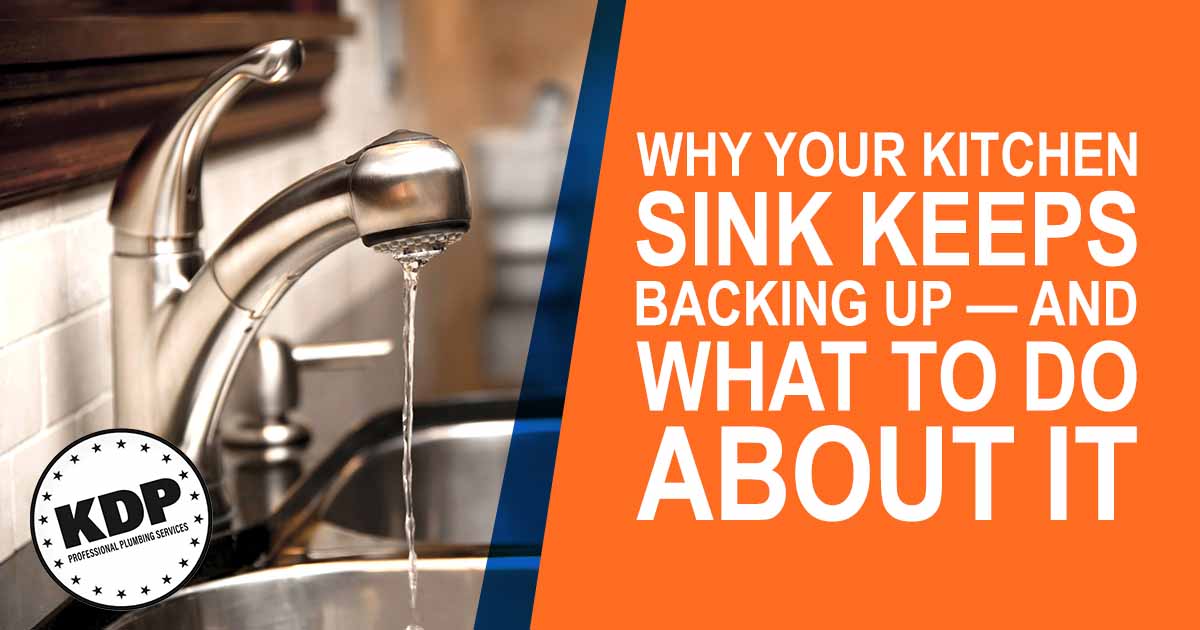A kitchen sink backing up is more than an inconvenience—it’s a sign that something is wrong with the plumbing system. While occasional clogs can happen in any home, repeated sink backups usually point to a more serious issue. Homeowners may notice slow drainage, standing water, or foul smells coming from the drain. Understanding the common reasons behind a kitchen sink backing up can help identify when a DIY fix is possible and when to contact a licensed plumber.
Common Reasons for a Kitchen Sink Backing Up
Grease and Oil Buildup
Grease is one of the most common causes of a kitchen sink backing up. When cooking oil, butter, or fat is poured down the drain, it can solidify and coat the inside of the pipes. Over time, this buildup narrows the pipe and restricts water flow. Even if hot water seems to wash it away, the grease often cools and hardens further down the line, causing persistent clogs.
Food Scraps and Debris
Kitchen sinks often back up due to rinsing or scraping food waste into the drain. Items like coffee grounds, eggshells, pasta, rice, and fibrous vegetables can accumulate, leading to slow or blocked drainage. While garbage disposals can help break down food, they don’t prevent clogs if non-disposable items are put down the sink.
Pipe Blockages and Structural Issues
Older or damaged pipes are another common cause of sink backups. Corrosion, mineral deposits, or misaligned joints can trap debris and reduce the diameter of the pipe. Tree roots can sometimes infiltrate underground pipes, creating blockages that affect indoor plumbing, including the kitchen sink.
Poor Drain Ventilation
Drainage systems require proper venting to allow air to enter and maintain pressure. If a vent is clogged or improperly installed, it can create suction and prevent water from draining correctly. This may cause the kitchen sink to drain slowly, make gurgling noises, or back up completely.
DIY Fixes to Try When Your Kitchen Sink Is Backing Up
While a kitchen sink that backs up repeatedly should be inspected by a plumber, homeowners can try a few safe methods to clear minor clogs before making a service call. These do-it-yourself options are low-risk and can sometimes resolve simple blockages caused by food residue or grease buildup.
Boiling Water Flush
Pouring boiling water down the sink is a basic method for dissolving soap scum or soft grease. Bring a kettle or large pot of water to a boil and slowly pour it down the drain in stages, allowing each pour to work for a few seconds. This approach is most effective for light clogs and should not be used if PVC pipes are present, as high heat may cause damage.
Baking Soda and Vinegar Method
Combining baking soda with white vinegar is a simple way to break down light buildup and reduce odors in the drain. Begin by adding half a cup of baking soda to the drain, then pour in one cup of vinegar. Cover the drain to allow the reaction to work, and let it sit for 10 to 15 minutes. After the wait, rinse the drain using hot water (not boiling). While this method may ease minor clogs and improve smell, it won’t be effective for clearing more serious blockages.
Manual Plunging Techniques
A standard cup plunger can help dislodge minor blockages. Fill the sink partially with water and position the plunger over the drain to create a tight seal. Use firm, even thrusts for 15–20 seconds. If the water begins to drain, the blockage may be cleared. If there is a double-basin sink, seal the other drain with a wet cloth or stopper to maintain pressure.
When to Avoid Chemical Drain Cleaners
Chemical drain openers may seem like a fast solution, but they carry risks. Harsh formulas can damage plumbing—especially in older homes—and may not remove the clog entirely. Overuse can also lead to pipe corrosion and environmental harm. These products should only be considered a last resort and never used in combination with other cleaning agents.
When It’s Time to Call a Professional Plumber
If a kitchen sink backs up despite multiple home remedies, it’s likely time to call a licensed plumber. Persistent or recurring clogs usually indicate an underlying problem that cannot be solved with DIY methods alone.
Signs That DIY Fixes Aren’t Working
The issue may be more serious when basic methods like boiling water, plunging, or baking soda and vinegar have little or no effect. Signs that point to the need for professional help include:
- The sink backs up again shortly after clearing
- Water backs up into other fixtures, like a dishwasher or adjacent basin
- Strong, unpleasant odors are coming from the drain
- Gurgling sounds continue even when the sink is not in use
These symptoms may indicate deeper blockages, damaged pipes, or ventilation issues that require expert tools to diagnose.
Risks of Ignoring a Recurring Kitchen Sink Backup
Delaying professional service can lead to bigger problems. Standing water in the sink can cause damage to cabinets and countertops. Repeated backups increase the risk of mold, mildew, and bacteria growth in and around the drain area. In severe cases, pressure buildup in blocked pipes may lead to leaks, pipe bursts, or structural damage behind walls and under flooring.
What a Licensed Plumber Can Do That You Can’t
Professional plumbers have tools and techniques that go far beyond what is available to homeowners. These include:
- Video camera inspections to locate and identify the cause of deep clogs or pipe damage
- Hydrojetting equipment that clears the entire line using high-pressure water
- Drain augers and plumbing snakes to remove blockages without damaging pipes
They can also check for improper installations, collapsed pipes, or venting problems—ensuring the issue is fully resolved and won’t return.

